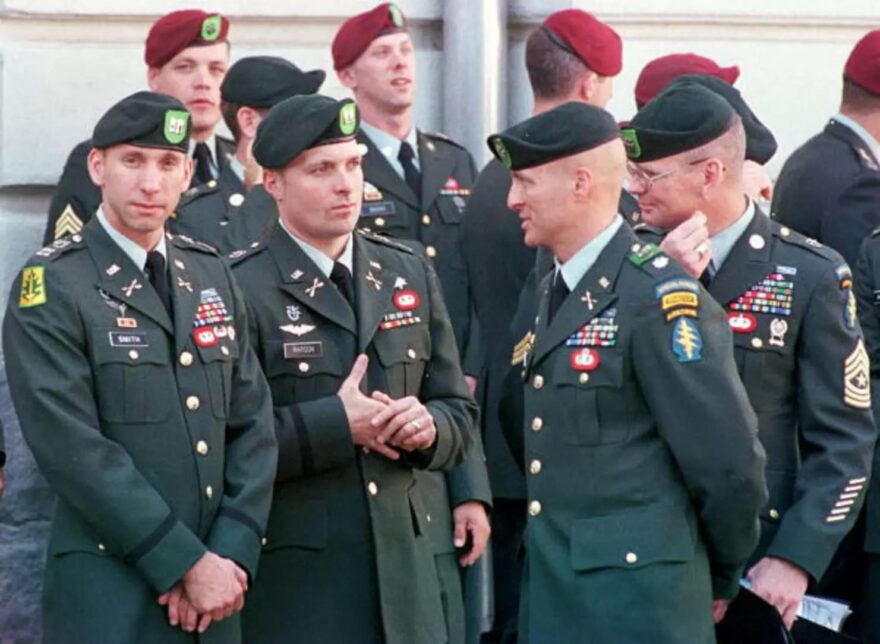The Green Berets are the Army’s elite counter-terrorists, foreign internal defense specialists, and reconnaissance troops. They serve around the world to secure America’s strategic interests. Though their missions are sometimes confused with Navy SEALS’ and Army Rangers’, Special Forces operate in a league of their own. They are “jacks-of-all-trades,” Anne Jacobsen writes in her book, “Surprise, Kill, Vanish.” The term “Green Beret” derives from the green beret insignia worn on their hats. The hats symbolize the Green Beret’s unmatched mastery of quiet, guerilla war-style operations.
They are the Army’s most lethal warriors, crossing behind enemy lines, hunting down terrorists, training guerrilla armies, and other operations that defy all standards and conventions. They are highly intelligent, incredibly versatile professionals who are often in places that no other military can get to.
The Green Berets have the highest casualty rate of any group in the United States. In order to carry out their extremely complex and dangerous missions, the elite soldiers must be jacks-of-all-trades. They must be experts in unconventional warfare, direct action, foreign internal defense, reconnaissance, and more. They must also be culturally fluent and mentally sharp, speaking multiple languages and deeply immersed in culture and critical thinking. Their ethos is competence, confidence, and humility, tinged with a commitment to public service and a strong dose of patriotism.
What Are the Green Berets’ Missions?
Special Forces, and the Green Berets in particular, are the tip of the spear when it comes to the United States’ fight against diverse enemies around the world. They specialize in unconventional warfare, counterterrorism, foreign internal defense, reconnaissance, direct action, and hostage rescue missions. The Green Berets’ heavy deployment rotations have earned them the highest casualty rate in all Special Operations forces. Conventional military units are extremely good at what they’re built to do, but they can’t match the expertise and specialized equipment that the Army Rangers, Navy SEALs, and Marine Raiders bring to their jobs.
Successes by the Green Berets have fueled demand for this elite force, which is called upon to do what other military forces can’t or wouldn’t dare try. The mission of the Special Forces is embodied by their motto, “Sine Pari,” which means “without equal.”
To do that job well requires an extraordinary amount of training and experience, along with a shared bond of brotherhood. The successful completion of a grueling Special Forces selection program and then integrating into an Operational Detachment Alpha (ODA) builds extreme trust, as does countless deployments that are physically and mentally demanding. It is this spirit of brotherhood that drives every Green Beret’s relentless pursuit of excellence on a daily basis. Their missions, which are shaped by the ever-changing threats of this globalized world, exceed all standards and defy all conventions.

What Are the Green Berets’ Qualifications?
Green Berets must be able to operate in hostile environments and without any support, often working with foreign forces. They need to be able to communicate with local people in their native language and learn the culture of their host country. They must also be able to perform highly technical tasks, from combat operations to intelligence gathering and counterinsurgency.
They must also be highly trained in special warfare tactics and weapons, such as assault rifles, pistols, shotguns, sniper rifles, and grenades. But perhaps the most important qualification is a desire to push the limits and defy convention. To be a Green Beret is to be a warrior who strikes fear into the hearts of our nation’s enemies.
After President Kennedy’s death, the Army’s special operations force grew significantly. All three existing Special Forces groups expanded to their full strength, and four new ones emerged: one at Fort Bragg, oriented towards Africa and Latin America, and another in Panama, geared toward Central Asia.
These newest forces needed to be staffed, and the demand for Green Berets increased even further. To meet manpower goals, the Special Warfare School began to accept Army recruits as well as volunteers. Washout rates fell, and the pool of potential candidates increased.
